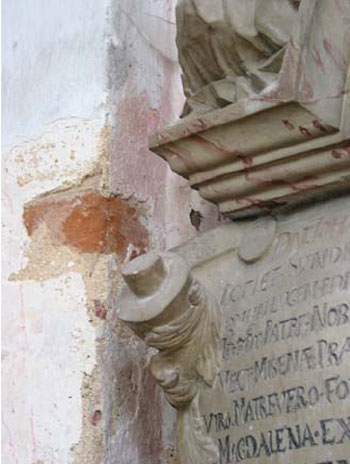Academic thesis
| Carla Leupold: | Microbially induced pink coloration on wall surfaces. Clarification of the basic growth conditions. | Back |
| Language: | Original - Translation | |
| Overview: |
|
|
 Example of microbially induced pink coloration on a wall surface
|
|
| Abstract: | The phenomenon of microbially induced pink coloration on wall surfaces has been known since the sixties. The cultivation of the responsible bacteria was difficult from the beginning. Only methods of molecular biology have proven successful in researching the characteristics of the red-pigmented microorganisms. In order to clarify basic growth conditions, this research assessed and compared 12 different architectural surfaces focussing on climate conditions, salt load, and their composition. The evaluation considered previous studies and own analysis. All 12 objects had problems with high atmospheric humidity and wet walls over a long period of time. All objects were also highly affected by damaging salts. Analysis has shown that the pink areas exhibit a high concentration of sodium carbonates. Consequently, the pH-values were in the alkaline region. Regarding the grounding, the pink bacteria were always on lime surfaces with assumed organic components. Closer information about these components could not be obtained. Summing up, it can be said that this research paper has successfully recorded a number of the significant conditions that lead to the phenomenon of pink bacteria on wall surfaces. |
 Crystallisation of salts on an infested area
|
|
| Details: |
|
| Download: |
full-text thesis (pdf-data format, approx. 11.86 MB) |
| DOI (Digital Object Identifier) | 10.5165/hawk-hhg/111 |
| Back | |
The Hornemann Institute offers only the information displayed here. For further information or copies of academic work, please contact the author or - if there is no contact provided - the secretariats of the respective faculties.